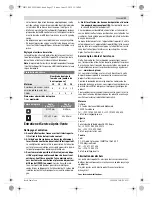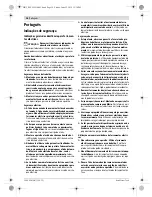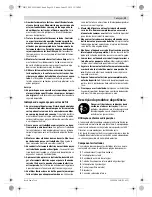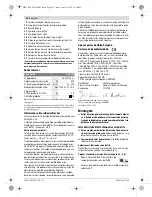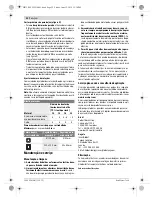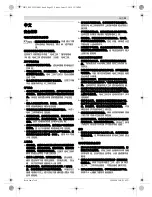
10
| English
1 609 92A 19N | (12.6.15)
Bosch Power Tools
Dust/Chip Extraction
Dusts from materials such as lead-containing coatings,
some wood types, minerals and metal can be harmful to
one’s health. Touching or breathing-in the dusts can cause
allergic reactions and/or lead to respiratory infections of
the user or bystanders.
Certain dusts, such as oak or beech dust, are considered
as carcinogenic, especially in connection with wood-treat-
ment additives (chromate, wood preservative). Materials
containing asbestos may only be worked by specialists.
– Provide for good ventilation of the working place.
– It is recommended to wear a P2 filter-class respirator.
Observe the relevant regulations in your country for the
materials to be worked.
Prevent dust accumulation at the workplace.
Dusts can
easily ignite.
Operation
Before any work on the machine itself, pull the mains
plug.
Starting Operation
Starting and Stopping (see figure B)
To save energy, only switch the power tool on when using it.
– Switch the toggle switch
2
upward (Position
I
).
– To
start
the machine, press the On/Off switch
5
and keep
it pressed.
– To lock the
pressed
On/Off switch
5
, press the lock-on
button
4
.
– To
switch off
the machine, release the On/Off switch
5
.
When the On/Off switch is locked on, press the On/Off
switch through until the lock-on is disengaged and then re-
lease the On/Off switch.
Switching the “PowerLight” On/Off
The “PowerLight” LED light
13
enables the work area to be il-
luminated in adverse lighting conditions.
– To
switch on
the light, press the switch
14
to position
.
– To
switch off
the light, press the switch
14
to position
.
Working Advice
When working with the machine, always hold it firmly
with both hands and provide for a secure stance.
The
power tool is guided more secure with both hands.
Do not touch the workpiece before it has cooled down.
The workpiece becomes very hot during sawing.
Heavy workpieces must be underlaid or supported.
Wear safety shoes.
Sawn-off workpieces can injure you
when falling.
Do not strain the machine so heavily that it comes to a stand-
still.
Excessive feed significantly reduces the performance of the
power tool and the lifetime of the band-saw blade.
Freehand Cutting (see figure C)
Secure the workpiece.
A workpiece clamped with clamp-
ing devices or in a vice is held more secure than by hand.
– For
freehand cutting
, the band-saw blade
12
must run
between the saw blade guides
18
and the workpiece stop
11
must be pulled out fully:
Insert the band-saw blade accordingly.
If required, loosen both hex socket screws
21
using the
hex key provided
8
and pull the workpiece stop
11
out ful-
ly. Tighten both hex socket screws again.
– Select the suitable cutting position for your workpiece, so
that as many teeth as possible of the band-saw blade
12
are in the cut. (see figure E)
– Switch on the power tool, position it on the workpiece with
the workpiece stop
11
and lower the band-saw blade
12
slowly into the cut.
– Work with moderate pressure and uniform feed.
– Reduce the pressure just before ending the cut and slightly
raise the machine, so that it does not fall on the workpiece.
Cutting Close to Walls (see figure D)
– For
cutting close to walls
, the band-saw blade
12
must
run around the saw blade guides
19
and the workpiece
stop
11
must be pushed in fully:
Insert the band-saw blade accordingly.
If required, loosen both hex socket screws
21
using the
hex key provided
8
and push the workpiece stop
11
up-
ward fully. Tighten both hex socket screws again.
– Select the suitable cutting position for your workpiece, so
that as many teeth as possible of the band-saw blade
12
are in the cut. (see figure E)
– Switch on the power tool, position both guide plates
10
flush against the wall and lower the band-saw blade
12
slowly into the cut.
– Work with moderate pressure and uniform feed.
– Reduce the pressure just before ending the cut and slightly
raise the machine, so that it does not fall on the workpiece.
Adjusting the Speed
You can use the speed regulator
3
to continuously adjust the
required speed of the power tool depending on the band-saw
blade used and the material being worked.
Note:
Do not change the speed during cutting! Otherwise, the
machine may become damaged or the band-saw blade may
break.
Speed setting
Number of teeth on band-
saw blade (TPI = teeth per
inch)
Material
10
14
18
24
Soft steel, aluminium, copper,
stainless steel, high carbon
steel
6
6
5–6
< 5
Cables
6
6
6
6
OBJ_BUCH-2519-001.book Page 10 Friday, June 12, 2015 12:34 PM

















